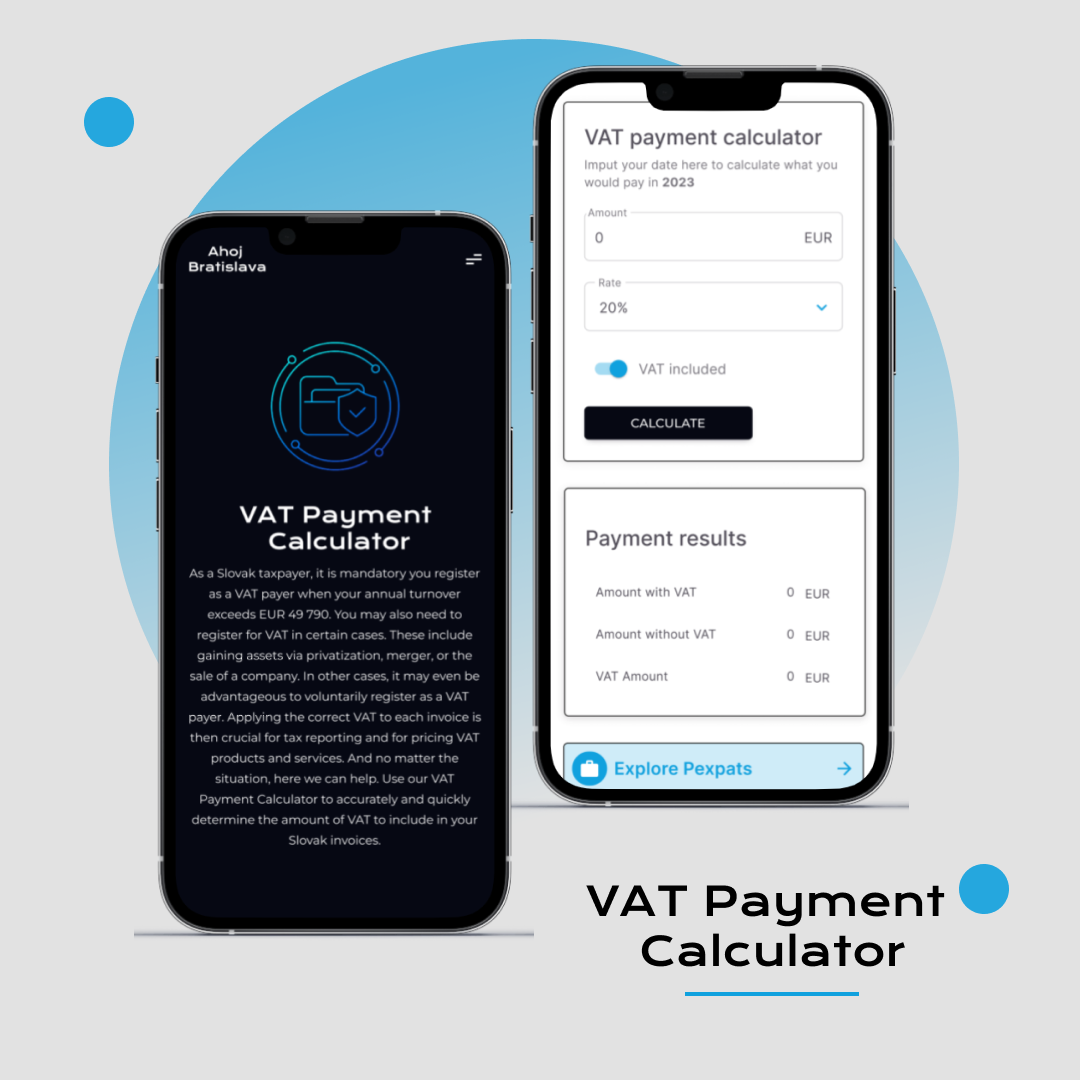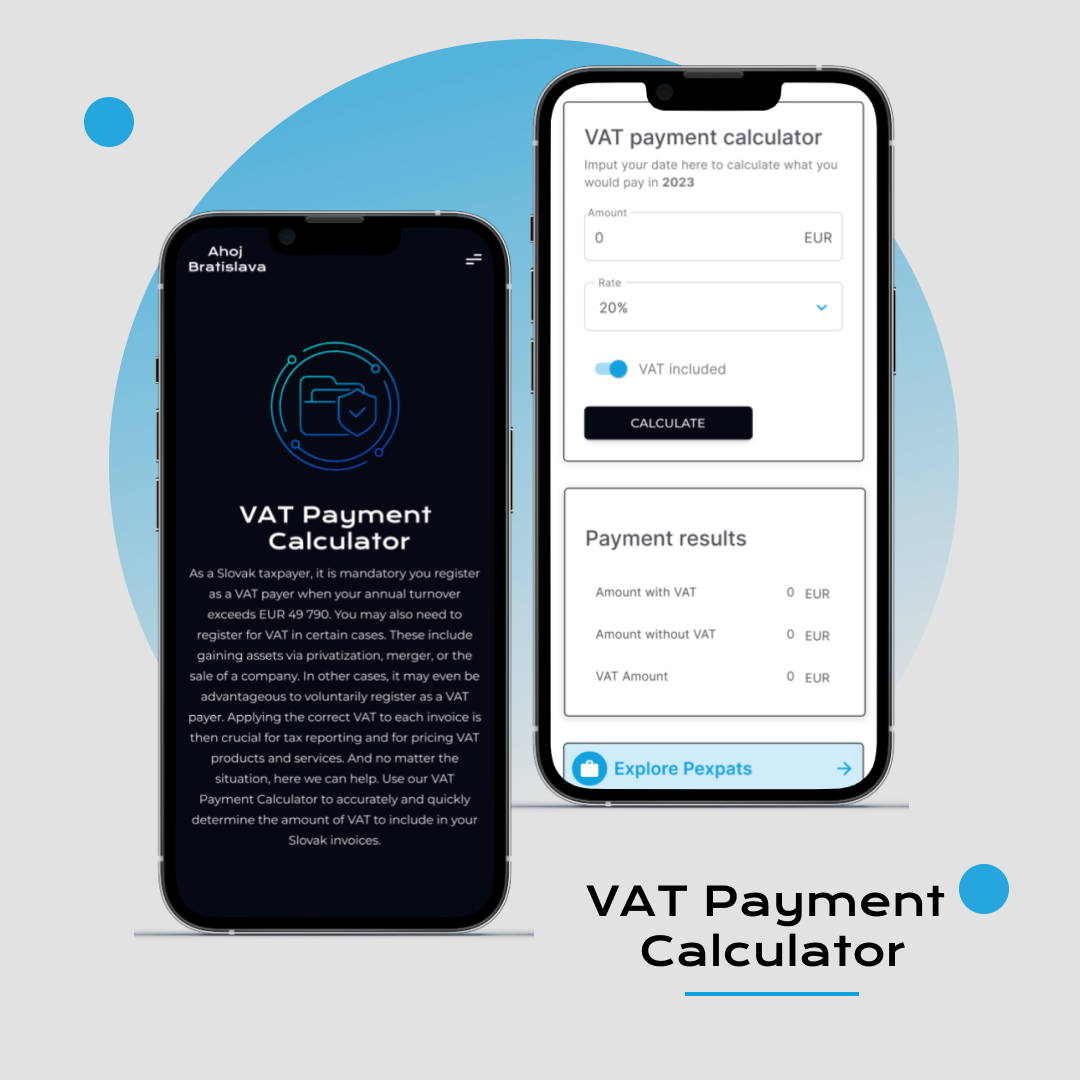
Slovakia Value Added Tax (VAT) - Info, Rates and Compliance
Understand value added tax in Slovakia, including general information, rules, rates, registration procedures, and mandatory compliance.
VAT in Slovakia - Info, Rates, and How to Register
Value added tax (VAT) in Slovakia follows similar rules, rates, and registration procedures as it does across most European countries. It is a general consumption tax, which applies to the purchase price of goods and services.
The VAT payer is responsible to pay VAT as an indirect tax into the central government budget. They must submit the so-called VAT Control Statement, providing specific tax documents to record tax evidence. The VAT payer has a VAT number (IČ DPH) for VAT reporting, and they must declare certain transactions.
VAT rates vary depending on the specific products and services, as well as the taxable person registered for VAT. But who needs to register for VAT? And what are the different rates? Read on to learn more about:
- Value added tax in Slovakia
- VAT rates
- VAT exemptions
- Slovakia VAT rules
- How to register as a VAT payer
- How to pay VAT
- How to apply for a VAT refund
1 - Value added tax in Slovakia
Value added tax is regulated by the “VAT Act” (per § 27 of Act no. 222/2004 Coll. on value added tax). It is an additional charge which the final consumer pays in addition to the price of certain goods or services. The VAT payer (the supplier) collects this tax from the consumer in the price of the transaction. They are then responsible for paying VAT into the central government budget.
As a VAT payer, applying the correct VAT rate to your products or services is thus crucial to calculating taxes. It is equally important for the process of pricing your goods and services.
VAT rates in Slovakia (2023)
As of 2023, there are three different VAT rates in Slovakia. These are:
- The basic VAT rate - 20%
- The reduced VAT rate - 10%
- The reduced VAT rate - 5%
The reduced 10% rate applies for example to:
- the sale of books
- some foods
- select medical devices
- accommodation services
- goods and services within the social economy
As of 2023, the reduced 10% VAT rate additionally applies to some sport and restaurant related services.
Another change includes the reduced VAT rate of 5%, which applies to rental housing. We’ll share more on this below.
Products and services under the reduced 10% VAT rate
A reduced tax rate of 10% of the tax base applies to selected goods under Annex no. 7 of the VAT Act, and services under Annex no. 7a.
Selected goods at a 10% VAT rate include for example:
- Selected types of food (bovine, pigs, sheep, goat, offal, poultry, fish)
- Selected dairy products (some milks and creams, butter, cheeses)
- Other food products (honey, potatoes, vegetables, fruit, bread, salt, etc)
- Selected medicines and medicinal supplies (antibiotics, pharmaceuticals, diagnostic and laboratory reagents)
- Accommodation services (hotel and similar accommodation services, tourist and short-term stay services, campsites, recreational holidays, etc)
- Books, newspapers, and magazines (under certain conditions)
This is with the exemption of imported goods in which a tax is already recognized and paid in accordance with regulations.
Goods and services that fall under Annex 7a of the VAT Act apply to an entity if:
- The goods or services fall within the framework of social economic activities.
- It is a registered social enterprise that uses 100% of its after-tax profit to achieve its main agenda.
- The social enterprise delivers to an authorized consumer who is a taxable person, or a natural person subject to the social economy or public administration.
- This activity does not distort internal market economic competition.
Further, as of 2023, the reduced 10% VAT rate additionally applies to restaurant, catering, and sports related services with a high energy demand.
Reduced 10% VAT rate for gastronomy and sports
Until 31 March 2023, the reduced VAT rate of 10% also applies to:
- Transportation to and from gastronomy or sport related services by cable car, ground lifts and ski lifts
- Activities to facilitate the practice of sports, either indoor or outdoor
- Entrance for artificial swimming facilities, entrance fees to fitness centers
- Restaurant and catering services
However, for restaurant and catering services, applying the reduced VAT rate of 10% comes with some complications. Mainly, the service of food or drink must accompany services allowing for their immediate consumption. This means sufficient space for consumption, providing service, washable crockery and cutlery, etc.
The main concern here is the focus on selling a service rather than goods. For example, delivering food or selling takeaway will not fall under the reduced 10% rate. In cases such as these, the basic VAT rate of 20% applies.
Reduced 5% VAT rate for rental housing
As of 1 January 2023, a new reduced tax rate at 5% of the tax base applies to:
- The delivery of a building or part of a building for state-supported rental housing. (This includes the construction site where the building or part of the building exists. However, delivery must meet the conditions for the construction of state-supported rental housing. Further, this must be within the social policy of the state. The recipient must be the lessor of the state-supported housing, with a subsidized state rental housing agreement.)
- State-supported rental housing renovation and reconstruction. (The building must meet the conditions for state-supported rental housing. In this case, the recipient must also be the lessor, and possess a contract for the operation of the housing.)
Note: In both cases, the building, part of building, reconstruction or reconstruction does not apply to non-residential property.
Vat exemptions
The cases in which goods and services can be exempt from VAT in Slovakia include two categories. One is for supplies which possess the right for VAT deduction on input, and the other is in cases where no such right exists.
Supplies with the right for VAT deduction in Slovakia include:
- Delivery of goods to another EU member state;
- Supplying an international passenger transport device;
- Exporting goods outside of the EU.
Supplies without the right for VAT deduction are:
- Financial services;
- Insurance services;
- The delivery and rental of real estate property.
2 - VAT rules in Slovakia
In general, VAT rules don’t differ much from Slovakia to across the EU. However, they can differ in certain aspects. For example, in Slovakia, VAT is added to the sale of goods and services, and the purchase of goods from abroad.
This includes other EU member states as well as third countries. Usually, the supplier of the goods pays VAT, although exceptions do exist when the buyer pays VAT. Overall, VAT is a fundamental component to pricing goods and services.
The VAT Act stipulates a turnover limit for mandatory registration as a VAT payer. In 2023, this amount is EUR 49 790 over the last 12 consecutive calendar months.
3 - How to register as a VAT payer
Regardless of turnover, all foreign entities in Slovakia must register for VAT if they intend to:
- Supply goods
- Sell services
- Buy goods from EU countries outside of Slovakia
However, note that this does not apply to transactions in Slovakia to a Slovak business. It also does not apply to real estate rental to a Slovak business from a supplier within the country.
In order to register as a VAT payer, foreigners must submit an application of registration to the Tax Office of Bratislava. The tax office then registers the foreigner within 7 days of the application. Applicants can register via post, electronic submission, or in person.
All applications must also include:
- A foreign business register extract, or one from a similar business register. (You have to officially translate this into Slovak language, unless the original is in Czech.)
- A power of attorney if applicable, such as if an agent is acting on your behalf. (This should also be in Slovak language, and is mandatory for anybody from a third country.)
More information for EU nationals registering for VAT is available through the Financial Administration.
4 - How to pay VAT
After registering for VAT, you pay VAT at the end of any tax period. The tax period may be a calendar month, or a calendar quarter. It depends on the VAT payer and their obligations. VAT payers must then file a VAT return within 25 days from the end of this tax period.
They have to correctly identify and send each payment to the corresponding account number. Note: It is only possible to file VAT returns electronically.
You calculate what you pay in VAT by deducting goods and services you have been charged VAT on from your total VAT payable.
However, you will only have to file a VAT return if:
- You have the obligation to pay tax in the given tax period, or
- There was participation in an intra-community supply or export of goods from Slovakia, or
- You were a first customer in a triangle trade, or if you are applying for a tax deduction.
Additionally, the VAT Act stipulates that in some cases foreign entities must submit a ledger statement or recapitulative statement.
5 - How to apply for a VAT refund
The VAT refund is the most common method to apply for deductions on VAT payable on incoming supplies in Slovakia. It is also possible for foreign entities within the EU to apply for a refund on Slovak VAT they have paid. However, the foreign entity must meet certain conditions. These include that:
- They were purchasing goods and services in Slovakia (for example: selected medical devices), or
- They’ve imported goods into Slovakia.
To apply for a VAT refund, the applicant must:
- Apply electronically via the portal from your country;
- Apply no later than 30 September of the taxable year following the period of the refund;
- Provide a copy of the invoice or import document (if the VAT base is EUR 1,000 or higher, or EUR 250 or higher for a fuel purchase import).
The Bratislava Tax Office is then responsible for deciding on your VAT return application. Tax authorities must do this within four months of receiving the application, unless requesting more information from the applicant.
For foreign entities claiming a tax refund from outside of the EU, Annex no. 2 of the VAT Act provides a sample application.
Need an easy way to calculate VAT payments?

Make your life a bit easier with a completely free VAT Payment Calculator. Calculate exactly how much VAT to include on your Slovak invoices, quickly and easily. Simply fill in the total amount for any payment, select the VAT rate, and the calculator does the rest.
Did you like this article?
😒
🙂
😍
Made with ❤️ in Prague for Bratislava.
Powered by
